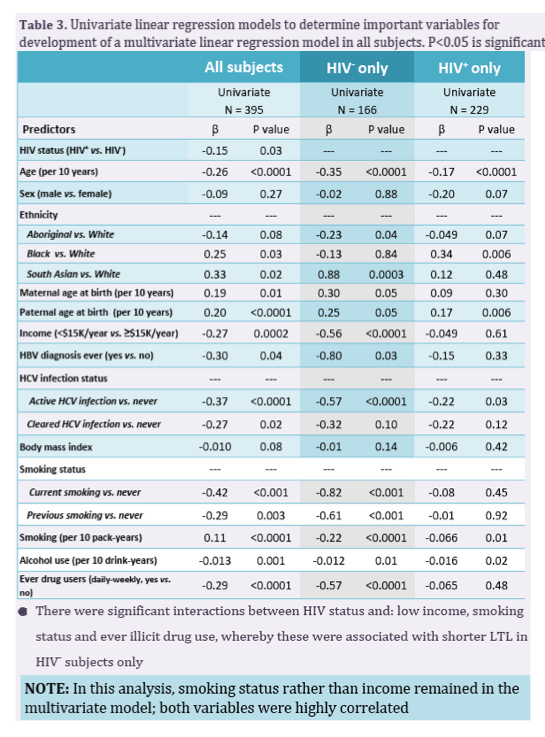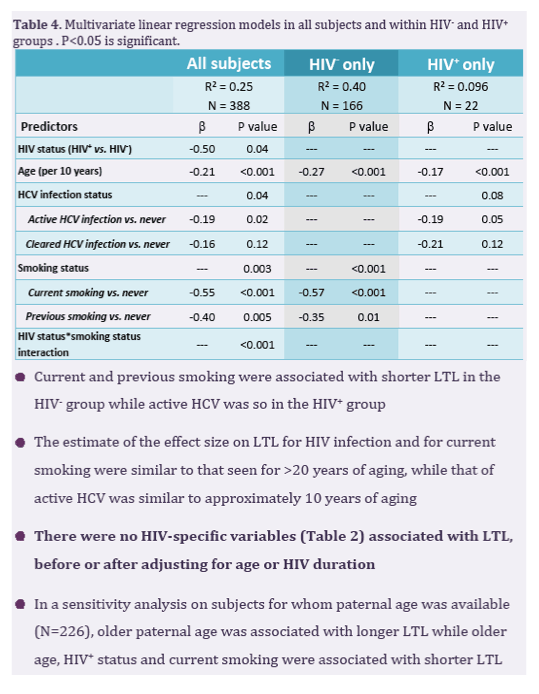 |
 |
 |
| |
HIV+ Status, Low Income, and Active Hepatitis C Virus Infection are Associated with Shorter Leukocyte Telomere Length in a Cohort of HIV+ and HIV- Adults
|
| |
| |
Reported by Jules Levin
CROI 2013
DeAnna Zanet*1, A Thorne2, B Sattha1, E Maan3, I Gadawski1, M Murray1,3,4, J Singer1,2, D Money1,3,4, N Pick1,3,4, H Cote1,4, and CIHR Emerging Team in HIV Therapy and Aging
1Univ of British Columbia, Vancouver, Canada; 2CIHR Canadian HIV Trials Network, Vancouver; 3Oak Tree Clin, Vancouver, Canada; and 4Women's Hlth Res Inst, Vancouver, Canada

(from jules: I think it is important to bear in mind that 40% of subjects in the study had detectable HIV viral load so you don't know the impact of if there was a difference between patients with vs without undetectable viral load, but I think the finding that HCV affects shorter LTL may not affected by HIV viral load being detectable, still the authors should do this analysis).

Abstract
Background: Leukocyte telomere length (LTL) is a marker of aging. Oxidative stress related to HIV-induced inflammation, chronic immune activation, ART and/or ART-mediated inhibition of telomerase activity could accelerate LTL shortening.
Methods: Blood was collected prospectively from HIV+ and HIV- adults enrolled in the CARMA cohort study and LTL was measured by quantitative polymerase chain reaction (qPCR). Variables univariately related to LTL (p <0.15) were used as candidates in the development of a multivariate model. Among HIV+ subjects, HIV-related factors were examined similarly.
Results: LTL was measured in 229 HIV+ (median age [range] = 40 years [20-77], 79% female) and 166 HIV- (38 years [21-73], 71% female) subjects.
Shorter LTL were univariately associated with older age, pack-years smoking, illicit drug use, and active hepatitis C virus (HCV) infection (all p <0.0001), HIV+ status (p = 0.031), and income <$15,000/year (p = 0.0002).
Having an older father (p <0.0001) or mother (p = 0.021) and being black (p = 0.031) or South Asian (p = 0.018) vs white were univariately associated with longer LTL.
Several variables showed significant interactions with HIV status, notably smoking, illicit drug use, and low income; these were associated with shorter LTL in HIV- subjects only.
In the multivariate model (R2 = 0.24) that included an HIV*income interaction (p = 0.034), older age (p <0.0001), HIV+ status (p = 0.004), low income (p = 0.001), and active (p = 0.004), but not cleared HCV infection (p = 0.22) vs HCV- were associated with shorter LTL. Father's age was not included in this model as data were missing for 210/395 subjects.
In a sensitivity analysis of subjects with known father's age (n = 185), results were similar but HCV was no longer significantly associated with shorter LTL and younger paternal age was (p <0.0001). ART duration, CD4 count, CD4 nadir, HIV duration, ART interruptions, and detectable plasma viral load were not univariately associated with LTL.
Conclusions: These results suggest that apart from aging and having a younger father, HIV+ status, low income (a possible surrogate for lifestyle/environmental factors), and possibly active HCV infection are the strongest predictors of short LTL and may affect cellular aging. Of note, some factors typically associated with shorter LTL (e.g., smoking) emerged only among HIV- subjects, suggesting other factors may overwhelm their effect in HIV+ individuals. We could not detect evidence that ART-related factors impact LTL but further study should examine the potential impact of HIV and HCV therapy on LTL.


(from jules: we do not understand as we have not adequately researched the affects of protease inhibitors or NNRTIs so this notion that NRTIs are bad & assuming the other classes are safe is not established).





|
| |
|
 |
 |
|
|